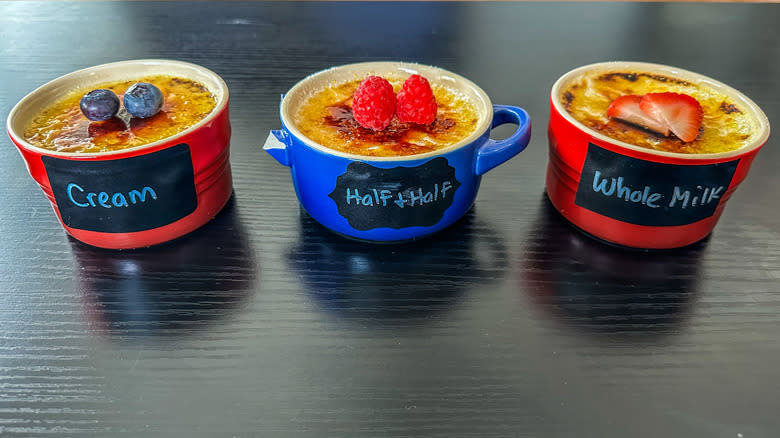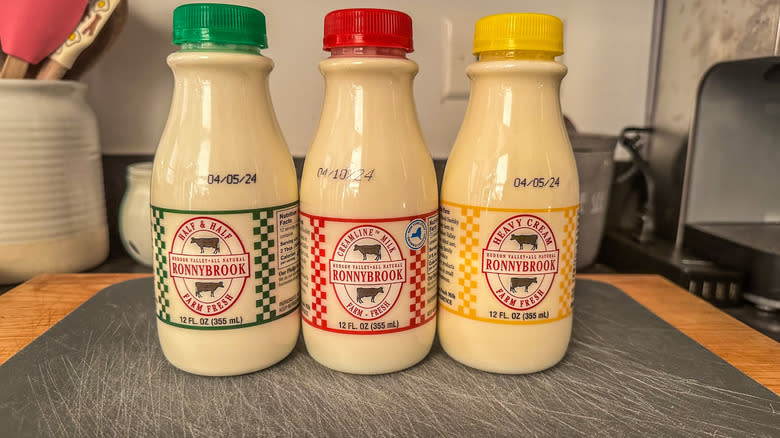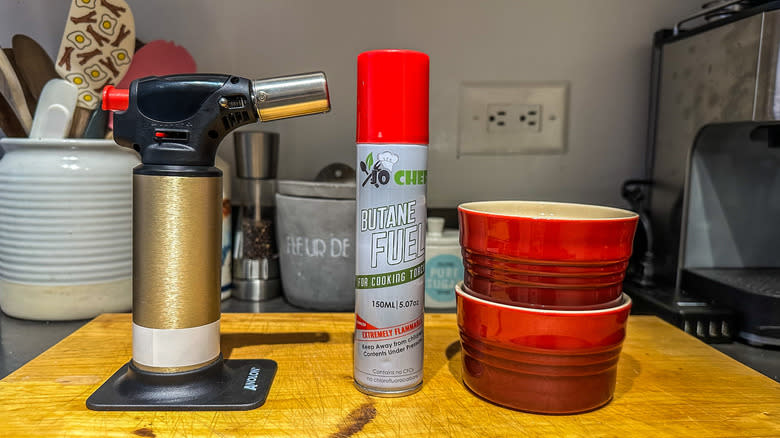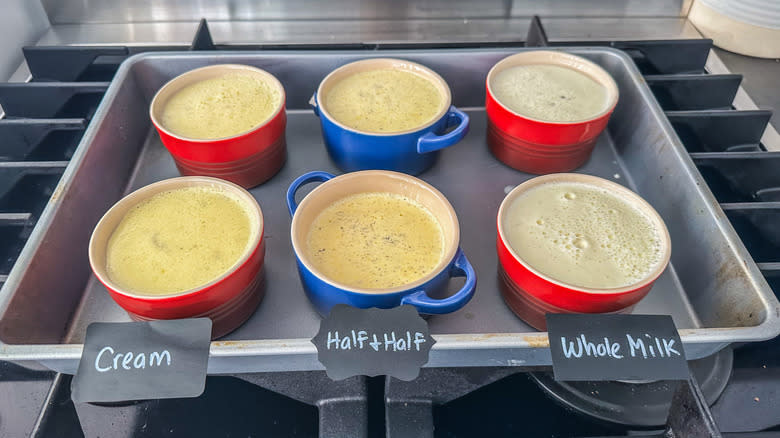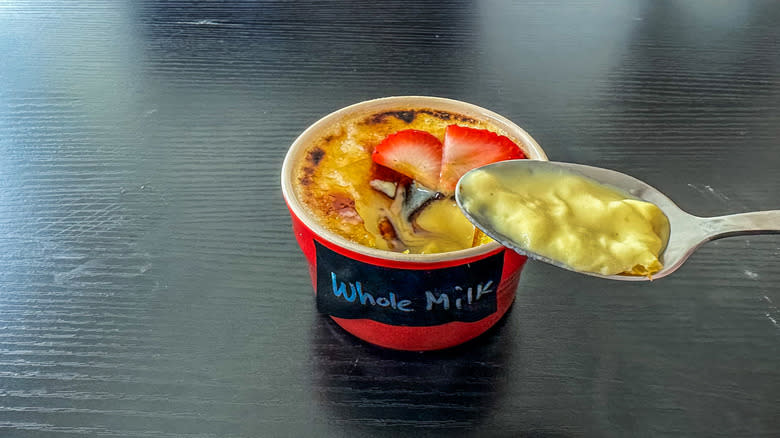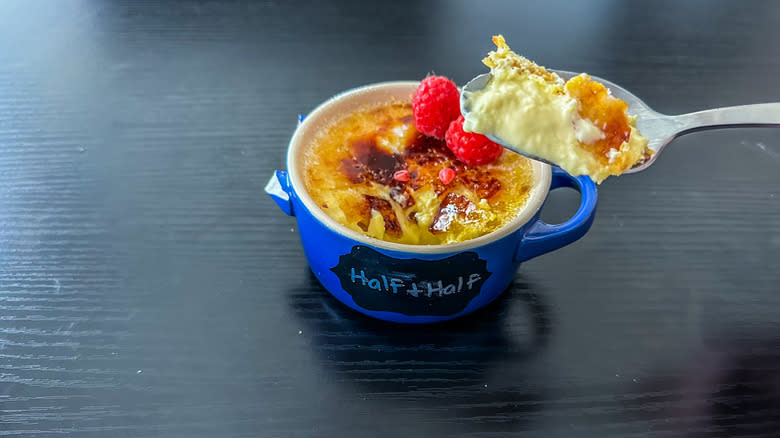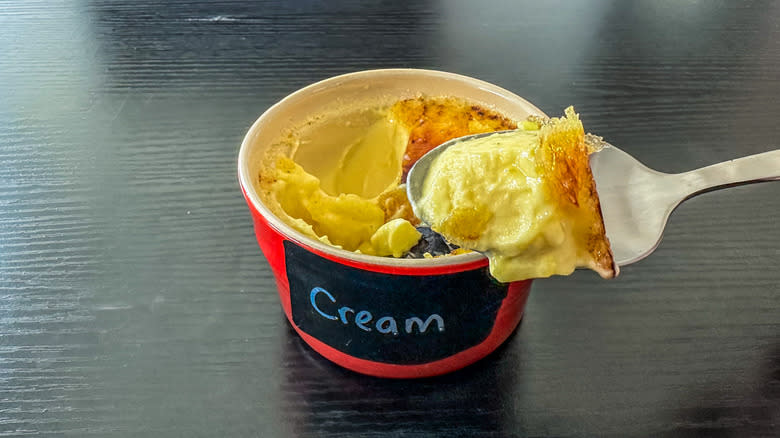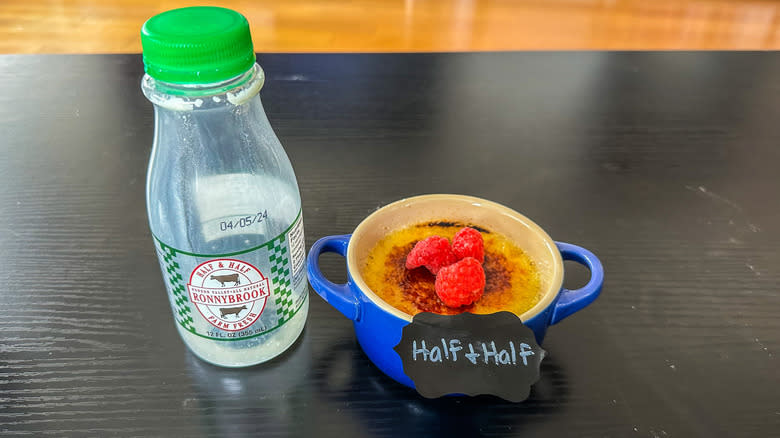Eating a well-made crème brûlée is a transformative experience.It's a simple dessert made with four ingredients, baked in a water bath, and finished with a hard caramelized sugar topping. Although this French custard is a classic one, I wanted to know if it could withstand change in the form of an ingredient substitution.For the purpose of this test, I swapped out the traditional heavy cream with other dairy products to see if it would deliver the same delicious result.
As a graduate of the French Culinary Institute, I have made many classic crème brûléesin the past and feltconfident in my ability to create versions of the recipe using three different dairy products: whole milk, half-and-half, and heavy cream. I used milk from the same brand (Ronnybrook Farm) to ensure that the quality was consistent across the batches. In the end, I was looking to answer the age-old question: Is the written recipe the end-all-be-all? And after conducting a blind taste test with help from my husband, I felt that I was able to definitively answer that query.
Read more: 30 Types Of Cake, Explained
Heavy Cream Is The Traditional Dairy In Crème Brûlée
The French know a thing or two about making a tasty dessert, and crème brûlée is no exception. A big part of what makes a crème brûlée so downright delicious is the ingredients it calls for. While there are only a handful, they come together to create harmony in a ramekin.The crème brûlée base is typically made with heavy cream, which gives it an over-the-top, decadent, and rich flavor.
Heavy cream has a high fat content. It must have at least 36% fat to be considered heavy cream. If you compare that to the milk fat percentages in half-and-half and whole milk, it's a big jump. Half-and-half typically contains 10 to 18% milk fat, and whole milk is significantly lighter at approximately 3.25%. The fat is what makes the crème brûlée custard rich and buttery. And since the French are no strangers to fat, butter, and sugar when it comes to cooking and baking, it's no surprise that the luscious base of the classic crème brûlée relies so heavily on this specific dairy product and all the milk fat it offers.
Whole Milk Has Plenty Of Fat To Make For A Creamy Custard
Despite being lower in milk fat than half-and-half and heavy cream, whole milk can still be a fatty addition to various baked goods, from custards and cakes to bread and biscuits. Whole milk is also frequently used in sweet and savory dishes outside of baking and sweets. For example, you'll often see it used in abéchamel sauceor gravyto add depth and richness.
While a traditional crème brûlée doesn't call for whole milk as its custard base, plenty of other custards do. You can make abaked cinnamon custardwith whole milk for a light dessert that won't make you feel weighed down after eating it.Cherry clafoutis, another classic French dessert, features a sweet fruit-dotted batter made with whole milk and heavy cream. It has a very rich consistency, which makes it pleasurable to eat.
Kitchen Tools To Have On Hand
Crème brûlée is one of the few French desserts that requires little effort to make. However, it requires several kitchen tools, some of which you likely don't often reach for on a regular basis.
The most essential tool for the crème brûlée is a kitchen torch. You can't achieve the crisp brûlée, the layer of burnt sugar, without one. I used a smaller, hand-held version of the larger flame-thrower you may be picturing. It should be noted that there are many creative ways to use a culinary torch besides crème brûlée, so you'll use it (and the butane fuel) for more than just this dessert. You can purchase this torch through a kitchen store or online retailers like Amazon.
One of the best parts of crème brûlée is its presentation. The perfect way to achieve that adorable, single-serving look is to prepare it in a ramekin. Most crème brûlée recipes will have you prepare your custard and then divide it evenly between each ramekin, so having four to six 7-ounce ramekins on hand will make your crème brûlée preparation a breeze. You could also opt to make one giant crème brûlée in a tart shell, but I find that the custard bakes and sets more evenly in the smaller ramekins.
Preparing The Crème Brûlée
I chose to use a recipe that called for a water bath because itgenerates moisture in the oven for a gentle, even bake. This is important because it ensures the custard doesn't try out. I also wanted a recipe that was easy to follow and didn't overcomplicate things.
Sourcing out the ingredients for this recipe was relatively easy since almost all of them were pantry and fridge staples that I had on hand. But one ingredient that many home cooks might not already have is vanilla beans. While they can be found in the spice section at most grocery stores,they can be pricey and tend to only come with one or two pods per jar. If you want to make a crème brûlée at home but aren't open to spending much on this particular ingredient, you can swap in vanilla extract or paste instead. But to keep this recipe consistent, I stuck with the pods.
As with so many French desserts, the devil is in the details. The most challenging step in making crème brûlée isn't wielding the torch -- it's combining the hot milk with the eggs without causing the mixture to scramble. I added the hot liquid a little at a time to the yolks and whisked it constantly to ensure it didn't heat up too quickly and transform into an omelet. This resulted in smooth custard across all of the batches.
Taste Test: Whole Milk Crème Brûlée
I started my taste test with the lowest milk fat option in the lineup: the whole milk crème brûlée. Everything about this crème brûlée was different from a run-of-the-mill version. The whole milk dessert was far lighter in color than the rest, even before it was baked. After it came out of the oven, I noticed it was the still lightest one. Additionally, the whole milk crème brûlée took slightly longer to bake than the rest. The ramekins needed five more minutes in the oven than the two others.
This batch fell short of my expectations for flavor and texture. The vanilla bean flavor was present but could have been more profound. However, while there was less milk fat in this batch than the others, there was still a decently rich flavor.
This crème brûlée suffered in terms of texture. The custard, while fully cooked and set, was still pretty loose and jiggly. It lacked that luscious, velvety texture that a traditional crème brûlée is known for.
Taste Test: Half-And-Half Crème Brûlée
I made acrème brûlée with half-and-half as a middle-of-the-road milk fat option. Since there is a difference between the fat content ofhalf-and-half and heavy cream, I hypothesized that the custard would come out differently than the traditional dessert made with heavy cream. But maybe the extra creaminess could prevent some of the texture issues I noticed with the whole milk batch.
I noticed the half-and-half ramekin was a similar color to the heavy cream one before baking. It ended up browning slightly more on the top and took about the same amount of time to cook and set as the heavy cream crème brûlée. Texturally, the half-and-half crème brûlée was light and creamy and held together really nicely when I cracked into it with a spoon.
Despite using the same amount of vanilla in all three crème brûlées, the half-and-half batch had, by far, the most assertive flavor. The heightened richness and flavor gave thiscrème brûlée the best balance; it was creamy and sweet without being too eggy. Overall, it was beautifully light and had an almost fluffy consistency.
Taste Test: Heavy Cream Crème Brûlée
It's tough to say anything is wrong with a traditional crème brûlée. However, after trying the two othercrème brûlées made with different dairy products, I could see the bigger picture and give this timeless and classic dessert some honest, intentional, and constructive feedback.
The heavy cream crème brûlée set itself apart with flavor and texture from start to finish. Unlike the half-and-half and whole milk custards, the heavy cream version had the most yellow tint. It was the color of quality European butter. The pale yellow color was noticeably different from the stark whiteness of the other two. Plus, the taste of the heavy cream recipe was far richer and was on the edge of being too heavy. It had a thicker, more butter-like consistency.
This recipe offered a familiar, complete bite. All the elements of the classic crème brûlée were present, from the creaminess to the egginess. But compared to the half-and-half crème brûlée, the structure of the custard seemed almost too firm and thick, rather than being light (yet still decadent).
The Verdict: Which Crème Brûlée Was Best?
Right off the bat, the whole milk crème brûlée takes the bronze medal here. While it had a really lovely vanilla flavor, not having that extra milk fat made for a custard that lacked richness. The mousse-like texture that makes crème brûlée so enjoyable just wasn't there. The difference between the gold and silver here was small, but in the end, I decided that the half-and-half option was the best of the three.
This result was different than the outcome I expected. Since the time-honored crème brûlée is made with heavy cream, it seems only fitting that the traditional recipe would reign supreme. But, I thought that the half-and-half version offered the best vanilla flavor and balanced sweetness, along with a perfect mouthfeel.It was rich but not firm -- smooth and creamy but not overly jiggly. A heavy cream crème brûlée is luxurious and delicious, but the slightly lower milk fat in the half-and-half version made for the most balanced, enjoyable bite.
Read the original article on Tasting Table
